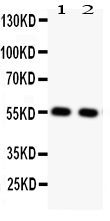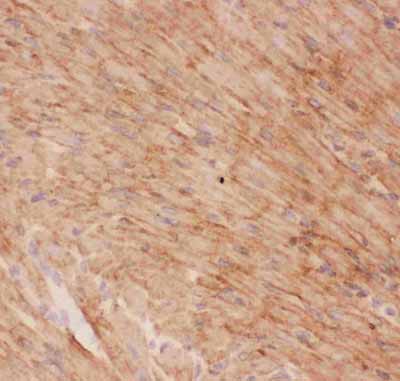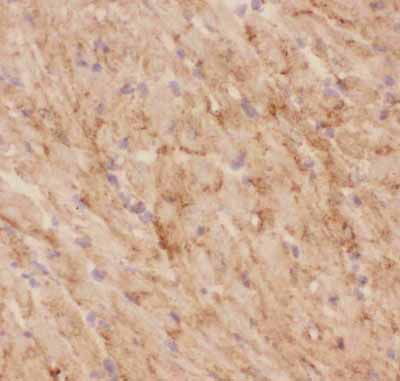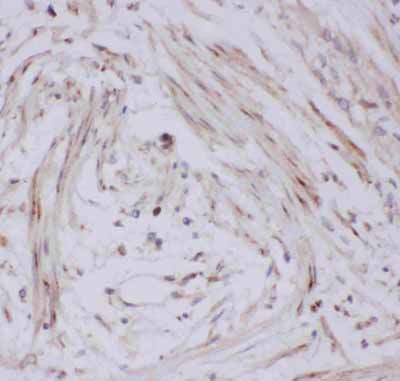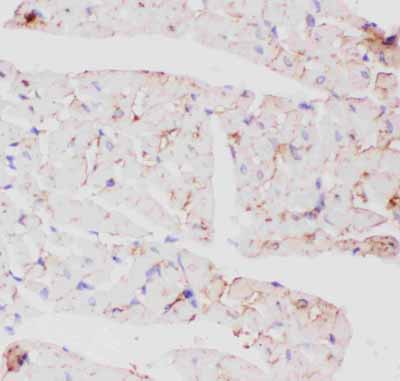Anti-GLUT4 Picoband Antibody
- SPECIFICATION
- CITATIONS
- PROTOCOLS
- BACKGROUND

Application
| WB, IHC-P, IHC-F |
|---|---|
| Primary Accession | P14672 |
| Host | Rabbit |
| Reactivity | Human, Mouse, Rat |
| Clonality | Polyclonal |
| Format | Lyophilized |
| Description | Rabbit IgG polyclonal antibody for Solute carrier family 2, facilitated glucose transporter member 4(SLC2A4) detection. Tested with WB, IHC-P, IHC-F in Human;Mouse;Rat. |
| Reconstitution | Add 0.2ml of distilled water will yield a concentration of 500ug/ml. |
| Gene ID | 6517 |
|---|---|
| Other Names | Solute carrier family 2, facilitated glucose transporter member 4, Glucose transporter type 4, insulin-responsive, GLUT-4, SLC2A4, GLUT4 |
| Calculated MW | 54787 MW KDa |
| Application Details | Immunohistochemistry(Frozen Section), 0.5-1 µg/ml, Mouse, Rat, - Immunohistochemistry(Paraffin-embedded Section), 0.5-1 µg/ml, Human, Mouse, Rat, By Heat Western blot, 0.1-0.5 µg/ml, Rat, Human |
| Subcellular Localization | Cell membrane ; Multi-pass membrane protein . Endomembrane system ; Multi-pass membrane protein . Cytoplasm, perinuclear region . Localizes primarily to the perinuclear region, undergoing continued recycling to the plasma membrane where it is rapidly reinternalized. The dileucine internalization motif is critical for intracellular sequestration. |
| Tissue Specificity | Skeletal and cardiac muscles; brown and white fat. |
| Protein Name | Solute carrier family 2, facilitated glucose transporter member 4 |
| Contents | Each vial contains 5mg BSA, 0.9mg NaCl, 0.2mg Na2HPO4, 0.05mg NaN3. |
| Immunogen | E.coli-derived human GLUT4 recombinant protein (Position: N333-D509). Human GLUT4 shares 97% amino acid (aa) sequence identity with mouse GLUT4. |
| Purification | Immunogen affinity purified. |
| Cross Reactivity | No cross reactivity with other proteins |
| Storage | At -20˚C for one year. After r˚Constitution, at 4˚C for one month. It˚Can also be aliquotted and stored frozen at -20˚C for a longer time.Avoid repeated freezing and thawing. |
| Sequence Similarities | Belongs to the major facilitator superfamily. Sugar transporter (TC 2.A.1.1) family. Glucose transporter subfamily. |
| Name | SLC2A4 (HGNC:11009) |
|---|---|
| Function | Insulin-regulated facilitative glucose transporter, which plays a key role in removal of glucose from circulation. Response to insulin is regulated by its intracellular localization: in the absence of insulin, it is efficiently retained intracellularly within storage compartments in muscle and fat cells. Upon insulin stimulation, translocates from these compartments to the cell surface where it transports glucose from the extracellular milieu into the cell. |
| Cellular Location | Cell membrane {ECO:0000250|UniProtKB:P14142}; Multi-pass membrane protein {ECO:0000250|UniProtKB:P14142} Endomembrane system; Multi-pass membrane protein. Cytoplasm, perinuclear region {ECO:0000250|UniProtKB:P14142}. Note=Localizes primarily to the perinuclear region, undergoing continued recycling to the plasma membrane where it is rapidly reinternalized (PubMed:8300557). The dileucine internalization motif is critical for intracellular sequestration (PubMed:8300557). Insulin stimulation induces translocation to the cell membrane (By similarity) {ECO:0000250|UniProtKB:P14142, ECO:0000269|PubMed:8300557} |
| Tissue Location | Skeletal and cardiac muscles; brown and white fat. |

Thousands of laboratories across the world have published research that depended on the performance of antibodies from Abcepta to advance their research. Check out links to articles that cite our products in major peer-reviewed journals, organized by research category.
info@abcepta.com, and receive a free "I Love Antibodies" mug.
Provided below are standard protocols that you may find useful for product applications.
Background
GLUT4, also known as SLC2A4 or solute carrier family 2 (facilitated glucose transporter) member 4, is a protein that in humans is encoded by the GLUT4 gene. It is mapped to 17p13.1. This gene is a member of the solute carrier family 2 (facilitated glucose transporter) family and encodes a protein that functions as an insulin-regulated facilitative glucose transporter. In the absence of insulin, this integral membrane protein is sequestered within the cells of muscle and adipose tissue. Within minutes of insulin stimulation, the protein moves to the cell surface and begins to transport glucose across the cell membrane. Mutations in this gene have been associated with noninsulin-dependent diabetes mellitus (NIDDM).
If you have used an Abcepta product and would like to share how it has performed, please click on the "Submit Review" button and provide the requested information. Our staff will examine and post your review and contact you if needed.
If you have any additional inquiries please email technical services at tech@abcepta.com.













 Foundational characteristics of cancer include proliferation, angiogenesis, migration, evasion of apoptosis, and cellular immortality. Find key markers for these cellular processes and antibodies to detect them.
Foundational characteristics of cancer include proliferation, angiogenesis, migration, evasion of apoptosis, and cellular immortality. Find key markers for these cellular processes and antibodies to detect them. The SUMOplot™ Analysis Program predicts and scores sumoylation sites in your protein. SUMOylation is a post-translational modification involved in various cellular processes, such as nuclear-cytosolic transport, transcriptional regulation, apoptosis, protein stability, response to stress, and progression through the cell cycle.
The SUMOplot™ Analysis Program predicts and scores sumoylation sites in your protein. SUMOylation is a post-translational modification involved in various cellular processes, such as nuclear-cytosolic transport, transcriptional regulation, apoptosis, protein stability, response to stress, and progression through the cell cycle. The Autophagy Receptor Motif Plotter predicts and scores autophagy receptor binding sites in your protein. Identifying proteins connected to this pathway is critical to understanding the role of autophagy in physiological as well as pathological processes such as development, differentiation, neurodegenerative diseases, stress, infection, and cancer.
The Autophagy Receptor Motif Plotter predicts and scores autophagy receptor binding sites in your protein. Identifying proteins connected to this pathway is critical to understanding the role of autophagy in physiological as well as pathological processes such as development, differentiation, neurodegenerative diseases, stress, infection, and cancer.
